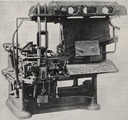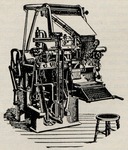The chart below is an attempt to lay out the evolution of the various Mergenthaler Linotype models. It was a relatively complex product line, but against that should be balanced two observations: First, it was a product line which evolved along largely compatible paths for over 80 years. This is a remarkable achievement. Second, it is easy to look backward to view a machine as an obvious failure or a particular development path as a dead-end. It is very much more difficult to look forward during development. In particular, the period from 1911 to 1924 encompassed a great burst of innovative development which included multi-magazine nonmixers, mixers with more than two magazines, and the first 72-channel display machines.
I would also note that although on the one hand the rebranding of the line as "Blue Streak" Linotypes in 1936 was a marketing campaign, it also reflected a significant point of re-engineering in the machines. I have in my reserve collection three Linotypes right next to each other: an early Model 5, a "Blue Streak" model 5, and a (Blue Streak) Model 31. In each case I had to partially disassemble the machine to remove it from its previous location. This is not a desirable method to move a machine, but it does have the advantage of revealing the underlying structure of the machine quite well. The two Model 5 machines are significantly different in their underlying structure, while it is difficult to tell the two stripped-down Blue Streak machines apart once their magazine equipment has been removed, even though one is a Model 5 and the other a Model 31.
Clicking on the image above should bring up a larger (2048 pixel wide) PNG version of it. Here is the same chart as a PDF (which might be more easily scalable): linotree-v4.pdf.
Here is the SVG format source file linotree-v4.svg.
This is a chronological account by date of first introduction. Model numbers may appear more than once, as re-engineered versions bearing the same number were introduced.
With a few exceptions, this account covers only machines which were used in commercial service, not development models. For more information on developments which did not see production, especially the pre-1886 experimental machines, see the Timeline of Composing Linecaster Development.

The "Blower" Linotype (1886-1890 in the US)
Introduced July 1886. 212 manufactured. Production terminated 1890. This was the first Linotype to see commercial service, although it was not necessarily available for general sale. It was not called the "Blower Linotype" at the time. It contained the four essential features of the Linotype (the cast slug-line, composition and casting integrated in a single machine, double-wedge line justification, and recirculating individual matrices), but it differed visibly from later machines (it had vertical matrix tubes for its "magazine," did not have a Second Elevator, and employed a chain-like segmented Distributor. As used commercially, its matrices employed Combination Teeth, but I do not yet know whether the rail pattern in the Distributor was binary; I suspect that it was not. Blower Linotype matrices were not compatible with later matrices. This was the machine for which the "etaoin" keyboard layout was devised, in order to overcome technical issues unique to it.

The "Square Base" Linotype (1890 in the US)
Intoduced in 1890. 366 manufactured. Replaced in 1892 by the Model 1. This was the first Linotype which (except for the structure of its base) took on an essentially "modern" form. It employed inclined (not vertical) magazines with constant-length channels (and an "etaoin" order). This overcame the risk of matrix damage which had been addressed by descending-length magazine tubes in the Blower Linotype, but put the Distributor further back on the machine. To address this, the Square Base machine added the Second Elevator. All Linotype (and compatible) matrices from this point on are mutually compatible (barring limitations in the widths of magazine channels, all matrices will run in all machines).
Most historians criticize its relatively massive base as unwieldy, as indeed it was criticized at the time. However, it is only 75 pounds heavier than a Model 1, and from the point of view of someone who has moved Linotypes it looks reassuringly stable.
Versions of the Square Base Linotype were produced outside of the US for a longer period of time (for example, by The Linotype Company in England and by the Canadian Linotype Company). This Notebook does not cover those in any detail.

Model 1 (1892)
The Model 1 was superseded by the Model 3 in 1902, but it was offered for sale through at least 1908 and remained available on special order through at least 1916.

The "Simplex" Linotype (Never Made In America)
There is no mention of a "Simplex" model Linotype in any American source until 1954. Neither Ottmar Mergenthaler nor the Mergenthaler company ever made a "Simplex Linotype." The term is an alternative name for the version of the Model 1 Linotype manufactured by Mergenthaler Setzmaschinen GmbH in Germany. It entered American usage in an abridged 1954 translation of a German book on Mergenthaler. Since then, its use has spread and it has caused considerable confusion. There are now sources which claim that Ottmar Mergenthaler built this machine, that it was the Model 1, that it was the "Square Base" Linotype, and even that it was the "Blower" Linotype. It has no place in the description of any American, British, Canadian, or any other non-German Linotype.
The Evolutionary Chart above deliberately excludes several models which are reasonably well known (to Linotype historians, at least) but which were either early models in limited production or were models which not really feature in the overall evolution of the Linotype. These are:
In addition to these, various sources list other more obscure models about which I presently know little. I need to track these down.
(The citations from George Corban Goble's dissertation are from his chart on p. 431; he in turn is quoting from a Mergenthaler Linotype Company salesman's book of 1971, so these models must really have existed. The citations from Leonard Spencer are on linotype.org. They reflect Intertype Corporation competitive study information.)
There was also a "Round Base Linotype" of 1898. (This is illustrated in the 1944 Milestones of Machine Typesetting and its invention is ascribed to Ottmar Mergenthaler. It isn't yet clear to me if it was made by his firm or the Mergenthaler Linotype Company.)
Goble (p. 95) cites the "Twin Linotype" built by Mergenthaler at his own Baltimore shop in the 1890s. He also says that Mergenthaler built 225 machines in this shop independently of the Brooklyn plant of the Mergenthaler Linotype Company; I don't yet know which model these were.
A number of sources, some of them quite authoritative, refer to either the Square Base Linotype or the Model 1 Linotype as the "Simplex" Linotype. However, I can find no evidence that any Linotype was called the "Simplex" within several decades of the manufacture of either of these machines; I do not believe that there was ever any such beast as the "Simplex Linotype." See the Notebook on the "Simplex" Linotype, above, for a more detailed discussion of this.
I have also seen reference to a "Linoquick." At present, I believe that this is in fact the Linofilm Quick, a phototypesetting machine. (But I may be wrong.)
All portions of this document not noted otherwise are Copyright © 2013 by David M. MacMillan and Rollande Krandall.
Circuitous Root is a Registered Trademark of David M. MacMillan and Rollande Krandall.
This work is licensed under the Creative Commons "Attribution - ShareAlike" license. See http://creativecommons.org/licenses/by-sa/3.0/ for its terms.
Presented originally by Circuitous Root®
Select Resolution: 0 [other resolutions temporarily disabled due to lack of disk space]